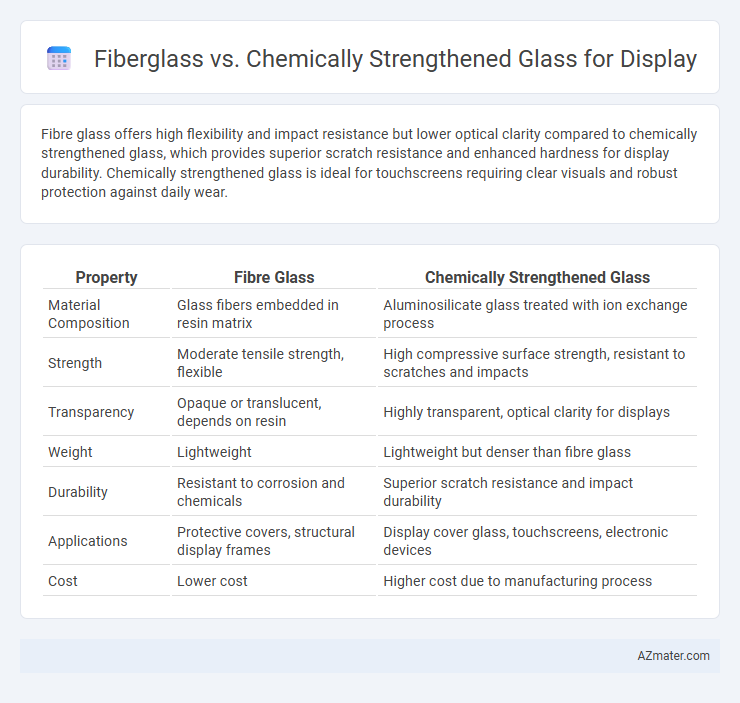Fibre glass offers high flexibility and impact resistance but lower optical clarity compared to chemically strengthened glass, which provides superior scratch resistance and enhanced hardness for display durability. Chemically strengthened glass is ideal for touchscreens requiring clear visuals and robust protection against daily wear.
Table of Comparison
| Property | Fibre Glass | Chemically Strengthened Glass |
|---|---|---|
| Material Composition | Glass fibers embedded in resin matrix | Aluminosilicate glass treated with ion exchange process |
| Strength | Moderate tensile strength, flexible | High compressive surface strength, resistant to scratches and impacts |
| Transparency | Opaque or translucent, depends on resin | Highly transparent, optical clarity for displays |
| Weight | Lightweight | Lightweight but denser than fibre glass |
| Durability | Resistant to corrosion and chemicals | Superior scratch resistance and impact durability |
| Applications | Protective covers, structural display frames | Display cover glass, touchscreens, electronic devices |
| Cost | Lower cost | Higher cost due to manufacturing process |
Introduction to Display Glass Types
Fibre glass offers excellent flexibility and lightweight properties, making it suitable for certain display applications requiring durability under stress. Chemically strengthened glass, through ion exchange processes, achieves enhanced hardness and scratch resistance essential for high-performance displays such as smartphones and tablets. Choosing the right display glass involves balancing mechanical strength, optical clarity, and resistance to impact and surface damage.
Overview of Fibre Glass
Fiberglass is a composite material made from fine glass fibers woven into a fabric and embedded in a resin matrix, offering high tensile strength and excellent impact resistance. It is lightweight, flexible, and resistant to thermal expansion, making it suitable for display applications requiring durable yet lightweight protection. Unlike chemically strengthened glass, fiberglass provides enhanced flexibility and shatter resistance but typically offers lower scratch resistance and optical clarity.
Overview of Chemically Strengthened Glass
Chemically strengthened glass undergoes an ion-exchange process that replaces smaller ions with larger ones on the surface, creating compressive stress that significantly improves its strength and scratch resistance compared to traditional glass. Unlike fiberglass, which relies on woven glass fibers embedded in resin, chemically strengthened glass maintains optical clarity and smoothness ideal for high-resolution displays. This glass type is widely used in smartphones, tablets, and touchscreens due to its superior durability and impact resistance without added bulk.
Key Properties: Strength and Durability
Chemically strengthened glass offers superior tensile strength and enhanced scratch resistance due to its ion-exchange process, making it highly durable for display applications. Fiberglass, while providing excellent impact resistance and flexibility, typically exhibits lower hardness and can be prone to surface abrasion. The choice between fiberglass and chemically strengthened glass hinges on the balance of strength requirements and expected wear conditions in the display environment.
Scratch Resistance Comparison
Chemically strengthened glass offers superior scratch resistance compared to fiberglass due to its ion-exchange process that hardens the surface, creating a durable and resilient layer resistant to everyday abrasions. Fiberglass, while flexible and impact-resistant, has a softer surface more prone to scratches from sharp objects or rough handling. In display applications, chemically strengthened glass ensures longer-lasting clarity and minimal surface damage, enhancing visual quality and durability over time.
Clarity and Optical Performance
Chemically strengthened glass offers superior clarity and optical performance for display applications due to its enhanced surface smoothness and reduced internal stress, resulting in minimal light distortion and higher transparency. Fiberglass, while strong and impact-resistant, typically exhibits lower optical clarity because of its fibrous structure, which can scatter light and reduce image sharpness. For displays demanding vivid color accuracy and sharpness, chemically strengthened glass is the preferred choice over fiberglass.
Flexibility and Thickness Variations
Fibre glass offers exceptional flexibility and can be manufactured in a wide range of thicknesses, making it ideal for curved or flexible display applications. Chemically strengthened glass provides high strength and scratch resistance but is typically limited in flexibility and available in thinner, uniform thicknesses to maintain structural integrity. For displays requiring dynamic bending and variable thickness, fibre glass is preferable, while chemically strengthened glass suits rigid, thin, and durable screens.
Manufacturing Processes and Cost
Fibre glass is produced using a process of melting silica and other raw materials, followed by drawing the molten material into fine fibers, which are then woven into mats; this manufacturing method is relatively low-cost due to inexpensive raw materials and high production speed. Chemically strengthened glass is created through an ion-exchange process, where smaller sodium ions in the glass surface are replaced by larger potassium ions from a molten salt bath, significantly enhancing strength but increasing production complexity and cost. The chemical strengthening process requires specialized equipment and precise control, making chemically strengthened glass considerably more expensive than fibre glass for display applications.
Environmental Impact and Sustainability
Fibre glass exhibits higher recyclability and lower carbon footprint due to its natural raw materials and energy-efficient manufacturing processes compared to chemically strengthened glass, which relies on energy-intensive ion-exchange treatments and non-renewable materials. Chemically strengthened glass, while durable, presents challenges in recycling because of its altered chemical structure, leading to increased environmental impact at end-of-life. Prioritizing fibre glass for display applications enhances sustainability by reducing resource consumption and facilitating circular economy practices in display manufacturing.
Best Applications: Choosing the Right Glass for Your Display
Fiberglass excels in applications requiring lightweight, impact-resistant display housings, making it ideal for rugged outdoor digital signage and protective screen enclosures. Chemically strengthened glass, known for its superior scratch resistance and clarity, is best suited for high-end touchscreens, smartphones, and tablets where durability and optical performance are critical. Selecting the right glass depends on the balance between environmental exposure and the need for visual precision in the display's intended use.

Infographic: Fibre glass vs Chemically strengthened glass for Display
 azmater.com
azmater.com